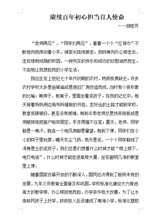仁爱版七年级下册英语复习知识点
有智慧没知识容易陷入空想,一事无成。有知识没智慧,就不要埋怨被人当做工具使用,用毕即弃。要善用智慧来运用知识,以求合理的表现。下面小阅给大家分享一些仁爱版七年级下册英语复习知识点,希望能够帮助大家,欢迎阅读!

仁爱版七年级下册英语复习知识1
重点语法
There be句型
Wh-questions
重点句型 What’s your home like? What’s the matter?
Sorry, I can’t hear you. I’ll get someone to check it right now.
There is something wrong with mykitchen fan.
重点讲解
1 house with three bedrooms.有三间卧室的房子。
with “有,带有”。
with还可以意为“和(某人/某物)在一起”
2 apartment for a family of two.适合两口之家的公寓。
(1) for表示“给……”表示目的或功能。
后接物主代词或名词,但通常带’s.或者后接表示无生命物体的名词。Here is a letter foryou.(2)of的含义为“属于某人/某事物”。
She is a friend of Lily’s. = She is Lily’s friend.
3 What’s the matter?怎么了?
该句常用来询问某或某物出了什么什么问题或毛病;
询问具体某人或某物出了什么问题时,
还可以表达为:What’s the matter with sb./sth.某人或某物出了什么毛病。
What’s the matter? = What’swrong?
4 Ihear you playing the piano.我听见你在弹钢琴。
hear…doing sth.“听见……在做某事”,强调正在进行的动作。
hear…dosth.“听见……做了某事”,强调全过程。
hearabout sth.听到关于某事物的消息 hear from sb.接到某人的来信、电话等
hear of sb./sth.听到或知道某人或某事物的情况
5 a lot of = lots of许多
后接可数名词,相当于many;
后接不可数名词,相当于much,
用于肯定句中;
但是注意:如果是否定句,则常用many或much.
6 be far from… 离……远(抽象距离)
be…away from…离……远(具体距离)
My school is not far from thebookstore. The sea is 2 miles away fromthe hotel.
7 There is something wrong with sb./sth.某人或某物出问题/有毛病了。
8 I’ll get someone to check it right now.我马上派人去检查。
get sb. to do sth.使某人做某事 someone=somebody某人
right now= at once= right away马上,立刻
语法讲解 There be…(表示“有”)用法
1.“There + be+主语+地点状语”表示“某处有某物”;地点状语也可放在句首,有时可用“,”与后面的部分隔开。There are some pictures on the wall.=On thewall, there are some pictures.
2.它的疑问形式是将“be”提到“there”之前。 Are there any books on the desk?
3. 它的否定形式是在“be”后加“not”.
4. There be如果后面接两个名词作主语,那么“be”的人称和数与邻近的名词一致。
仁爱版七年级下册英语复习知识2
重点语法
There be 句型和方位介词短语。
重点句型
There are two bedrooms and a a smallstudy.
Thereis a lamp, a computer, some books and so on.
—Is there a computer in your study? —Yes, there is.
Don't put them here. Put themaway.
重点讲解
1 It’s on the second floor.
在哪一层楼,用介词on。
on表示在……上面。
second是序数词,前面要用定冠词the, 意为第二(的)
巧辨异同 two与second
two是基数词
second是序数词,“第二”或“第二的”,指排列顺序。
2 in 在……里面,是方位介词。in the box in the classroom
Is there…? 表示某地存在……吗?
其肯定回答是:Yes, there is.
否定回答No, there isn’t.它的复数形式为
Are there…? 其肯定回答是:Yes, there are. 否定回答No, there aren’t.
3 巧辨异同 there be与 have
(1) there be“有”,指(某地)存在“有”。
(2) have“有”,指人或某物“拥有”。The is a dog in the picture. The dog has two big eyes.注:there be 遵循就近原则。be 用is还是are,取决于离该动词最近的那个名词。如果该名词是单数或不可数名词就用is,如果是复数就用are。
4 have a look看看。后面接名词时要用at. 如have a look at your watch.
5 talk about“谈论,议论”,后接名词或动名词。
talk with/to “与某人交谈”
6 用来询问某地有某物,其结构为:What’s+介词短语,回答时应用there be句型。
7 play with“和……玩耍”,“玩”
play with sb.“与某人一起玩”
8 put away 把……放好
9 look after“保管,照顾”,相当于take care of.
look at看……
look like看起来像……
look for寻找
look the same看起来一样
10 巧辨异同in the tree与on the tree
(1) in the tree 指外来物体在树上。
(2) on the tree树木本身长出来的花、树叶等。
11 巧辨异同like doing与like to do
like doing 表示经经常性或习惯性的兴趣、爱好。与love doing相似。
like to do 表示偶尔的、一次性的喜欢。与love to do相似。
12 I’m very glad to get a letter from you.我很高兴收到你的来信。
get a letter from sb. 收到某人的来信=hear from sb.
仁爱版七年级下册英语复习知识3
重点语法一般现在时和现在进行时的使用和异同。
重点句型
What day is it today? It’sWednesday.
Why do you like it? Because it’s easy and interesting.
What class are they having? They are having a music class.
重点详解
1 询问星期几用What day…?
回答:It’s Wednesday/Sunday…
与特殊疑问句词what有关的短语:
what class什么班
what color什么颜色
what time几点
what date几号(日期)
2 How many lessons does he haveevery weekday?
How many+可数名词的复数形式;
How much+不可数名词。
3 一个星期的第一天是Sunday, 在星期几前用介词on, 在具体点钟前用at.
4 learning about the past了解过去
learn about了
拓展
learn from向……学习
learn by oneself自学
5 What do you think of …? = How do you like…?你认为……怎么样?
6 —Why? —Because it’s interesting. 用why提问必须用because回答。
7 Which subject do you like best?你最喜欢什么科目?
like best最喜欢,可用favorite“特别喜爱的”转换。
8 be friendly to sb. 对某人友好
9 I can learn a lot from it.我能从中学到很多东西。(1) learn…from“从……学习”。
(2) a lot = much“许多”,后接宾语时要说a lot of 也可以表示“非常,十分”。
仁爱版七年级下册英语复习知识4
重点语法现在进行时态。
重点句型
What are you doing?
He is cleaning the dormitory.
Are you doing your homework? Yes, I am./No, I am not.
How long can I keep them? Two weeks.
重点详解
1 at the moment“此刻,现在”,相当于now.
2 巧辨异同go to sleep与go to bed
① go to bed“上床”“就寝”I often go to bed atten.
② go to sleep“入睡”“睡着”Last night I went tosleep at two o’clock.
3 巧辨异同some, a few 与a little“一些,有些”三者都修饰名词。
some既可以修饰可数名词又可以修饰不可数名词。
Wewant some apples and some water.
a few用在可数名词复数之前,a little用在不可数名词之前。
There are a few books and alittle waterin the classroom.
4 与how相关的短语
how often多常
how many多少
how much多少钱
how old多大
5 And you must return them ontime.你必须按时归还它们。
Return意为“归还,回归”
① return sth. to sb.把某物归还某人=give back sth. to sb.
② return to“回到…”,相当于come back to…
6 Maria and a girl are talking atthe lost and found.
talk“交谈”,常用的短语talk to/with sb.“与某人交谈”
巧辨异同talk, say, speak与tell
(1) talk“交谈”,表示通过谈话方式交换意见、消息等。
(2) speak“说话”,强调开口发声,后常接某种语言。
(3)say “说”,强调所说的话的内容。
(4) tell“告诉”,有时兼含“嘱咐”“命令”等。
tell a truth说真话
tell a lie说谎
tell a story 讲故事等固定搭配。
7.I can’t find my purse and I am looking forit. look for“寻找”,强调寻找的过程;
find“找到”强调找的结果。
8 .look(at), see与 readlook(at)指看的动作,see指看的结果,read常指看书、看报纸等。
9 .Here are some photos of his.这有他的一些照片。
photos of his是双重所有格。
his是名词性物主代词,后还可以接名词所有格。
a friend of mine我的一个朋友
a classmate of my brother’s我弟弟的一个同学
10 .I also want to go there oneday.我也希望有一天到那儿。
also意为“也”,常用于be动词和情态动词后面,实义动词的前面。
巧辨异同 also与too
also放在句中,too用于句末。
语法讲解 现在进行时
1.现在进行时表示:现在正在进行或发生的动作。
2.常用的时间状语:now, at the moment, look, listen等。
3.谓语动词构成:be(am/is/are)+v.-ing形式。
4.现在进行时态的肯定、否定和疑问式。
(1)肯定式:Iam running. You are running. He/She is running.
(2)否定式:I’mnot running. You aren’t running. He/She isn’t running.
(3)一般疑问句及回答:—Areyou running? —Yes, I am./—No, I am not.
—Is he/she running? —Yes, he/she is./ —No. he/she isn’t.
仁爱版七年级下册英语复习知识5
重点语法
一般现在时(常与频度副词never, seldom, sometimes, often,usually, always等连用)
重点句型
—How do you usually come to school?
—I usually come to school by subway.
—How often do you go to the library?
—Once/Twice/Three timesa week/Very often/Every day/Sedom
重点详解
1.I always come to school by bus.
by+交通工具名称,表示使用某种交通方式,中间不加限定词
如果交通工具前有a, the, my 等限定词,就不能用by,而是用in或是on.
on the train=by train on hisbike=by bike in my car=by car.
巧辨异同on foot 与 walk
on foot “走路”,是介词短语,不能作谓语,只作方式状语,位于句末。
walk “走路”,是动词,可以作谓语。
go to…on foot= walk to
I often go to school on foot. =I often walk to school.
go to….by bike = ride a bike to
go to…. by car = drive a car to
go to … by plane = fly to
go to… by bus = take a bus to
2 .Come on! It’s time for class.
come on “快点,加油,来吧”。
It’s time for sth. “该做某事了”= It’s time to do sth.
3 .look的短语
look the same看起来一样
look like看起来像……
look for寻找
look after 照顾
4 .do my homework at school 在学校做作业
do one’s homework 做家庭作业
(注意:one’s 要随主语的变化而变化,常用形容词性物主代词my, your, their, our,his, her等)。
5 we want to know about the school life of Americanstudents. 我们想了解一下美国学生的学校生活。
know about “了解,知道关于…”。
6 巧辨异同 a few与few
a few “一些”,few“很少,几乎没有”,修饰可数名词。
a little与littlealittle“一些”,little“很少,几乎没有”,修饰不可数名词。
7 They often play basketball or soccer, go swimming and so on.
go swimming 去游泳 and so on “等等”,表示还有很多。
拓展 go+v.-ing 表示去做某事,
go fishing 去钓鱼 go shopping 去买东西 go boating 去划船 go skating 去滑冰
8 How often do you go to thelibrary? 你多久去一次图书馆?
how often“多久一次”,问频率。
答语常用频度副词never, always,often等或单位时间内的次数
once a week一周一次
twice a month每月两次
three times a year每年三次
语法讲解 一般现在时
一般现在时表示:
(1)现在所处的状态。Jane is at school.
(2)经常或习惯性的动作。I often go to school by bus.
(3)主语具备的性格和能力。He likes playing football.
(4)客观真理。The earth goes round the sun.
常用的时间状语:often, always, usually, sometimes, everyday等等。
行为动词的一般现在时,助动词是do/don’t和does/doesn’t.
当主语是第一、二人称和所有复数形式时,行为动词用原形。
肯定式:I go to school on foot. 否定式:I don’t go to school on foot.
疑问式:Do you go to school onfoot? —Yes, I do. —No, Idon’t.
当主语是第三人称单数时,动词用第三人称单数形式,在词尾加-s或-es。
肯定式:He goes to work by bus.
否定式:He doesn’t go to work by bus.
疑问式:Does he go to work by bus? —Yes, he does. —No,he doesn’t.
仁爱版七年级下册英语复习知识点相关文章:
★ 英语七年级下册各单元知识点总复习
★ 七年级下册英语复习笔记
★ 仁爱七年级下册英语期末复习资料
★ 仁爱初中英语知识点总结
★ 仁爱英语七年级下册知识归纳
★ 七年级下册英语知识点笔记
★ 七年级英语下册语法重点知识点总结
★ 七年级英语语法知识点整理
★ 七年级下册英语知识点2024
★ 七年级英语下册知识点总结





